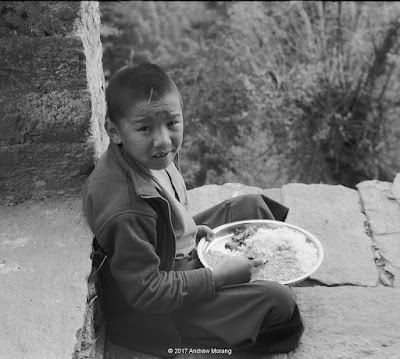During the first couple of days in Bhachchek, we kept hearing that schools would be closed on Wednesday. It was not a national holiday, so what was going on? Well, a country fair would be held at a bridge crossing over the Chepe Khola (river) at an elevation of about 900m. From Bhachchek, we had to descend about 900m to reach the crossing. (Note, click any picture to enlarge it.)
 |
| Rice fields below Bhachchek, approx. 1500m elevation. Exposed with a med. yellow filter to enhance contrast. |
Vertical change in Nepal is especially interesting because you pass through different botanical zones. Near Bhachchek, the forest was thick with hardwoods and Rhododendron. Then about half way down into the valley, terraces with rice fields appeared. The villagers labor heroically on these terraced platforms carved out of the hillsides by generations of farmers.
Finally, we reached the Chepe Khola and crossed the suspension bridge. Nepal has many bridges like this. They are not suited for vehicles, but local folks often push motor scooters over them, along with the occasional goat and donkey. This bridge was packed with people from the surrounding towns coming to enjoy the fair.
The tents were set up on the right bank of the river below some rice fields. The boulders show that occasionally, an immense flood roars down this valley, carrying along bus-sized boulders. The river runs clear here, showing that it has descended from a rocky mountainous area.
The gents love to gamble at these gatherings. In the upper photograph, they throw rings and win prizes. In the lower picture, the fellow rolls cubes with the same symbols as are on the mat. I gave him a few rupees and lost (surprise!).
The food vendors do a roaring business. They use portable propane stoves. I am not sure how they get all the supplies to the site.
The young ladies show up in their city clothes, checking out the scene.
Finally, for our return to Bhachchek, we took a jeep uphill, loaded with not only with our group but also some village ladies. In rural Nepal, jeep rented by foreigners = free transportation. We lurched, banged, and sloshed our way uphill, getting out at the worst mud pits while the driver negotiated his way through the muck. These Mahindra Bolero jeeps are rugged. One of our soft, sissified, leather-seated play-SUVs would not last more than a couple of kilometers on a Nepali mountain road. Mahindra almost totally dominates the market for pickups and jeeps, along with an occasional Suzuki and Toyota.

On Friday, we loaded into the Boleros and ground downhill on the spine-jarring track. Oops, a siren. Some Nepali soldiers were heading downhill in a hurry in a rather nice pickup. In a couple of minutes, there they were, axle deep in mud, rear wheels spinning vigorously. The soldiers got out with their guns, looking on as the driver continued to spin rear wheels. We suggested he engage 4WD. He said it was. No, the front wheels were not pulling at all. Perhaps he didn't turn the locking hubs? While the soldiers watched, the American tourists carried gravel and rocks to the puddle. There was no effort among the seven idle soldiers to push in a coordinated manner, as a US team would. We asked our Nepali school construction coordinator what they would do if they had to go to war? "They don't have the capacity."
Eight hours later, we beat our way into Kathmandu through the dense traffic. The mud was easier.
I took the black and white photographs with Ilford Delta 100 film using a Leica IIIC rangefinder camera and a 5cm f/2.0 Summitar lens (in the family since 1949). This little Leica is a handy and reliable travel camera, and is inconspicuous and un-intimidating compared to a monstrous contemporary DSLR cameras.
Dear Readers, this is the last of my 2017 Nepal entries. I hope they were of interest. On to other topics, other places, other adventures....






















































